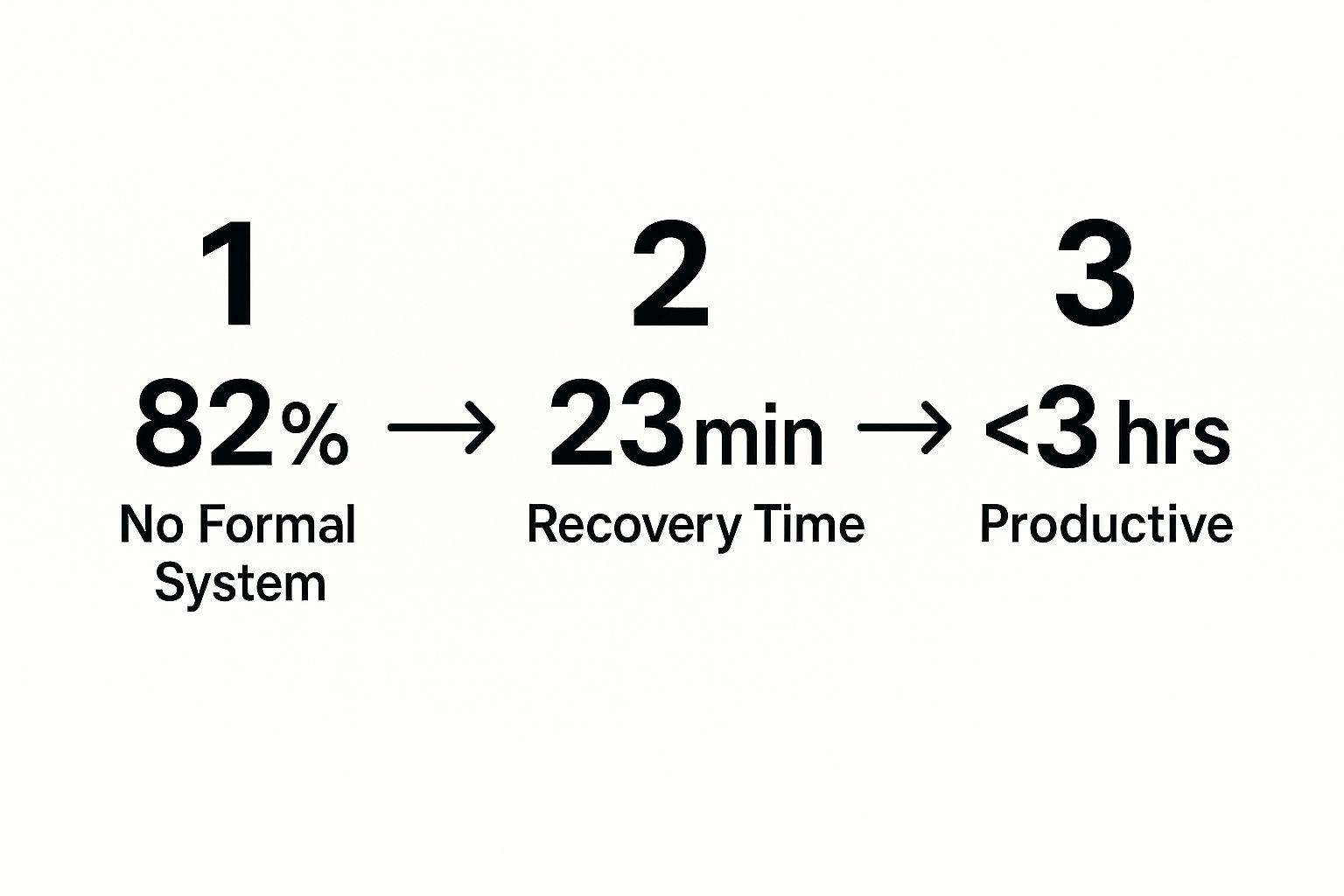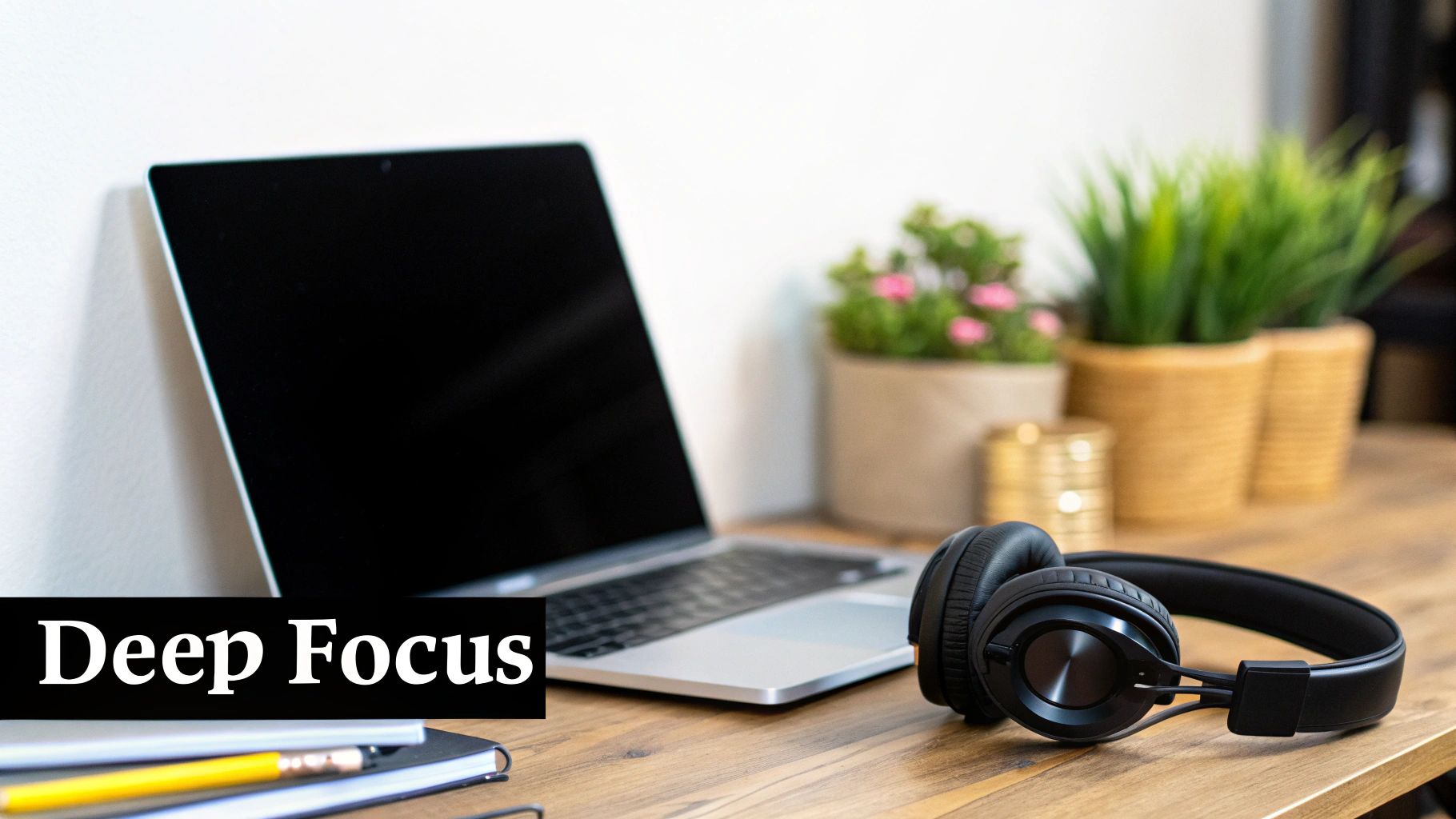Jan Elvis
11.10.2025

Jan Elvis
11.10.2025
If you constantly feel like you’re running out of hours in the day, the problem isn’t a lack of motivation—it’s a flawed method. True time management isn't about squeezing more tasks into your schedule. It’s about getting real about where your time actually goes and then building a system that puts the important stuff first.
Let's be honest, hearing generic advice like "just be more organized" is completely useless. The modern world is practically designed to distract you. If trying to manage your time feels like an uphill battle, you’re not alone. It’s the system that's broken, not you.
The real issue is that most people fight the symptoms instead of the cause. You might download the latest productivity app or buy a slick new planner, but those are just tools. Without a solid strategy behind them, they just add to the clutter.
There are a few key psychological and environmental traps that are probably derailing your best efforts. Pinpointing them is the first step toward building a routine that actually works.
This infographic breaks down the domino effect of poor time management, showing how a lack of system leads directly to hours of lost productivity.

As you can see, not having a structured plan means you're constantly losing time just trying to get back on track, which shrinks your effective workday down to almost nothing.
We've all got them—those little habits that seem harmless but slowly eat away at our day. Here's a quick look at some common time-wasters and what they're really costing you.
| Common Time Waster | Average Time Lost Daily | The Real Impact |
|---|---|---|
| Mindless Scrolling | 60-90 minutes | Kills momentum and leaves you feeling mentally foggy. |
| Unstructured Breaks | 45-60 minutes | Breaks that should be refreshing turn into procrastination sessions. |
| Notification Checks | 30-45 minutes | Constant context-switching destroys deep focus. |
These numbers add up fast, turning what could be a productive day into a frustrating scramble.
The stats tell a pretty clear story. An incredible 82% of people don’t use any kind of formal time management system, essentially just winging it through their days. The result? The average office worker is only productive for about 2 hours and 53 minutes per day. That’s a brutal reality check.
To fix what's broken, you have to get honest about where your time is going. This is the bedrock of building a disciplined routine that serves your goals, not your distractions.
Before you can build a better system, you need a clear baseline of your current habits. A great first step is to check out this comprehensive guide to conducting a time audit. It will help you pinpoint exactly where you're losing time and give you the clarity you need to finally create a schedule that works for you.

Alright, it’s time to stop chasing random productivity hacks and start building a system that actually works for you. A personal productivity system isn't some rigid rulebook you have to follow perfectly. Think of it more like a custom-built engine designed for one thing: helping you hit your goals with less drag.
The first move is to get crystal clear on your priorities. What actually moves the needle in your life right now? Is it nailing that certification for work? Hitting a new PR in the gym? Learning a new language? Get specific and write them down. This clarity is the foundation for everything else.
Once you know what matters, you need an honest look at where your time is actually going. This is where a quick time audit is invaluable. For just three days, log what you're doing in a simple notebook or app. Don't judge, just collect the data. You’ll probably be surprised—or even shocked—at how much time vanishes into social media rabbit holes or unplanned breaks.
After you’ve faced the reality of your schedule, you can start getting intentional. Instead of trying to juggle a dozen different techniques, pick one or two core methods to build your system around. This keeps things simple and prevents you from getting bogged down in the process. As you design your system, incorporating practical strategies to improve work efficiency will be a game-changer for getting more done without burning out.
Here are a couple of powerful, battle-tested methods you can make your own:
The real magic happens when you adapt these methods to your life. Maybe you time block your mornings for focused work and leave the afternoons more open for meetings and reactive tasks. Or you could use the Eisenhower Matrix every evening to set your priorities for the next day.
The goal isn’t to create a perfect, unbreakable schedule. It’s to build a flexible framework that eliminates daily guesswork and directs your energy toward what truly matters.
A productivity system that ignores your well-being is a system designed to fail. Burnout is the ultimate enemy of discipline and long-term success, so you need to schedule your recovery just as seriously as you schedule your work.
Building personal care habits is just as critical as your professional ones. For example, setting up a simple skincare routine for beginners is a small but powerful way to start and end your day with a sense of order and self-respect.
Make sure your system has non-negotiable blocks for:
When you build these things directly into your schedule, they stop being luxuries you hope to get to. They become a core part of your routine. This is how you create a balanced, sustainable system for success.

Let's be real: your ability to focus without getting sidetracked is your superpower. In a world of non-stop notifications and pings, the skill of deep work—that state of pure, uninterrupted focus on something tough—is what separates the guys who get things done from those who are just… busy.
This isn’t about gritting your teeth and "trying harder." It’s about being smart and setting up your environment to win. The stats are brutal: interruptions hit us about every three minutes, and it takes an average of 23 minutes to get back on track each time. You can go down the rabbit hole on how professionals are handling this by checking out the latest time management statistics from MyHours.com.
The first move? Declare war on your phone. Get ruthless. Set up "Focus Modes" that kill all but the most critical notifications during your work blocks. This isn't optional; it's essential.
Think of your attention span like a bicep. You can't just wake up one day and expect to curl a heavy dumbbell. It needs training, and one of the best workout routines for your brain is the Pomodoro Technique. It’s brilliantly simple.
You work, locked in, on one thing for 25 minutes. No email, no texts, no distractions. Then, you take a five-minute break. After four of these "Pomodoros," you earn a longer break, maybe 15-30 minutes. This trains your brain to stay on target in manageable chunks, building your endurance for those longer, more demanding deep work sessions.
The whole point is to make focused work a habit, not a heroic effort you have to psych yourself up for every time. You schedule it, you protect it, and you treat your undivided attention like the valuable asset it is.
Not everything you do requires a Herculean focus. We've all got "shallow work"—those low-effort, logistical tasks like clearing out your inbox, scheduling appointments, or filing expense reports. They have to get done, but if you let them pop up throughout your day, they become focus killers.
The solution is batching. Stop checking your email every time a new one lands. Instead, carve out specific times to handle all that noise at once.
Here's how it could look:
By corralling these shallow tasks together, you keep them from poisoning your high-focus periods. This opens up huge, clean windows of time for the deep, creative work that actually pushes you toward your goals. Pro tip: give your team or family a heads-up. A simple "Hey, I'm going dark for the next 90 minutes to focus on this project" works wonders. This is how you stop reacting to your day and start owning it.

The whole "hustle culture" narrative is a trap. We’ve been sold this idea that constant grinding is a badge of honor, but it's really just a direct flight to burnout. When you burn out, your ability to manage your time effectively gets completely torpedoed.
True productivity isn't just about what you accomplish during your work blocks. It’s just as much about how intelligently you recharge between them. You need to start treating rest with the same seriousness you'd give a major project deadline.
Strategic recovery isn’t lazy. It’s the fuel that powers high performance, sharp focus, and creative problem-solving. Without it, you're just running on fumes.
Let's get one thing straight: taking a break isn't weakness. The science is clear on this. Intentional downtime is when your brain actually consolidates memories and comes up with its best ideas. If you don't schedule rest, your body will eventually schedule it for you—usually in the form of getting sick or hitting a wall.
So, start blocking off recovery time directly in your calendar. This isn't just "free time"; think of it as a scheduled, non-negotiable appointment with yourself.
Strategic rest is an investment in your future productivity. By taking intentional breaks, you ensure that when you are working, you're operating at full capacity, not at a fraction of your potential.
You can have the most perfectly organized schedule in the world, but it means absolutely nothing if you’re sleep-deprived. Skimping on sleep wrecks your cognitive function, kills your mood, and makes it impossible to concentrate on anything.
Make 7-9 hours a night your non-negotiable goal.
A solid night's sleep is the bedrock of effective time management. If you're always tired and waking up with dark circles, it's a huge red flag that your recovery is failing. Improving your sleep hygiene is one of the single best things you can do for your daytime energy. For some solid advice on this, check out our guide on how to remove bags under eyes for men.
Ultimately, protecting your sleep is the ultimate productivity hack.
https://www.youtube.com/embed/3JW732GrMdg
Technology can be your greatest ally in building a disciplined life, or it can be a black hole of distraction that swallows your time whole. The difference boils down to one word: intention.
The goal isn't to download every shiny new "productivity" app that hits the market. It's about building a lean, purposeful digital toolkit where every single app serves a specific function. You want technology to automate the tedious stuff and simplify your workflow, not give you more feeds to check and notifications to manage.
Think of it as hiring a small team of digital assistants, each with one clear job.
Before you add anything new, you need to conduct a ruthless audit of your current setup. Take a hard look at your phone and computer. For every app you use for productivity—your calendar, to-do list, notes, project managers—ask a simple question:
"Does this actively solve a problem for me, or is it just adding to the digital clutter?"
If you have three different apps for taking notes, you don't have a system; you have chaos.
A scattered digital life creates mental friction. Every time you have to switch between apps or struggle to remember where you saved something, you lose focus and waste energy. Effective time management demands a streamlined command center.
Start by defining the core jobs you need your technology to handle. For most of us, this really only comes down to a few key functions:
The real discipline is picking one tool for each job and committing to it. Don't let your calendar become a messy to-do list, and don't try to schedule appointments in your notes app. When each tool has a distinct purpose, your entire system runs smoother.
Choosing a tool is less about its features and more about your commitment to using it consistently. A simple notebook you use every single day is infinitely more powerful than a complex project management app you only open once a week.
When you're deciding which apps will make the cut, it’s easy to get distracted by a million flashy features you'll never actually use. Resist that urge. The best tool is almost always the simplest one that solves your specific problem.
To help you decide, here’s a quick breakdown of the main tool categories and what to look for.
| Tool Category | Best For | Popular Examples | Key Consideration |
|---|---|---|---|
| Project Management | Tracking multi-step projects with deadlines and collaborators. | Asana, Trello, Monday | Does it provide a clear visual overview of progress? |
| Note-Taking | Capturing and organizing ideas, research, and information. | Notion, Evernote, Bear | How easy is it to find information once you've saved it? |
| Calendar Consolidation | Managing appointments and blocking out time for deep work. | Google Calendar, Fantastical | Does it sync flawlessly across all your devices? |
Ultimately, technology should reduce the number of decisions you have to make. A simple, intentional tech stack frees up your mental bandwidth to focus on what actually matters—the work itself, not the tools you're using to manage it. This is how you finally make technology work for you.
Look, having a plan is great, but life rarely goes according to plan. Theory is one thing, but actually putting this stuff into practice when you're staring down a deadline or just don't feel like doing anything? That's a whole different ball game.
This is where most guys get stuck. So, let's tackle the most common questions that come up when you start trying to wrestle back control of your time. Think of this as your go-to guide for the real-world friction you're bound to hit.
If you're just getting into this, forget the fancy apps and complicated systems for now. The most effective one-two punch is a simple Time Audit followed by Time Blocking. Start there.
First, you need to know where your time is actually going. For the next few days, track everything. Use a basic notebook or your phone's notes app. This isn't about judging yourself, it's about getting cold, hard data on your habits. You can’t fix what you can't see.
Once you have that honest baseline, you can start being intentional with Time Blocking. This just means you literally schedule blocks of time on your calendar for your most important tasks. Treat these blocks like you would a doctor's appointment—they're non-negotiable. This simple combo shifts you from reacting to your day to commanding it.
Here's the hard truth: motivation is fickle. It comes and goes. Discipline, on the other hand, is a system you build. You can't count on feeling motivated, so you need a system to fall back on when that feeling vanishes.
A killer tool for this is the Two-Minute Rule. If something on your list will take less than two minutes, just do it right then and there. Stop putting it off. For those bigger, more intimidating projects? Just commit to working on them for five minutes. Seriously. The hardest part is almost always just getting started.
Discipline is what you do when you don't feel like doing it. It's about honoring the commitments you've made to yourself, especially when the initial spark of motivation has faded.
It also helps to connect your tasks to a bigger "why." Instead of thinking, "Ugh, I have to write this stupid report," try reframing it: "Finishing this report gets me one step closer to that promotion." That small mental shift can make all the difference.
No plan survives first contact with reality. A flexible schedule will always beat a rigid one. The goal isn't to stop surprises from happening—it's to build a schedule that can take a punch without falling apart.
Start by building buffer blocks into your day. Literally schedule 30-60 minutes of empty time each day to handle whatever life throws at you. This buffer is your shock absorber. It prevents one urgent email from blowing up your entire afternoon.
You also need to develop an "urgency filter." When a new task lands on your desk, ask yourself: "Does this really need to be done right now, or can it wait?" Get good at telling the difference between a real fire and someone else's poor planning. Learning to politely say, "I can jump on that at 3 PM," is a superpower that protects your own priorities.
Honestly, neither one is better. The best system is the one you'll actually stick with. It all comes down to what fits your style and feels the most natural to you.
A lot of guys I know land on a hybrid approach. They use a digital calendar for meetings and appointments but use a paper notebook for their daily to-do list and jotting down ideas. Don't be afraid to experiment to find the combo that works for you.
At Main Character, we believe that building a disciplined routine is the foundation of confidence. It starts with small, intentional acts of self-care. Level up your daily regimen with our premium grooming products and start taking charge of your day. Explore the collection at dontlooktrash.com.